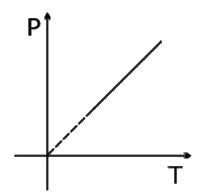P-V diagram of an ideal diatomic gas is a straight line passing through origin. The molar heat capacity of the gas in the process is xR. Find x (Here R - Universal gas constant)
The correct Answer is:7
To solve the problem, we need to find the value of x in the molar heat capacity C of an ideal diatomic gas, given that the P-V diagram is a straight line passing through the origin. Let's go through the steps systematically.
Step 1: Understand the P-V relationship
Since the P-V diagram is a straight line passing through the origin, we can express the relationship between pressure P and volume V as:
P=kV
where k is a constant.
Step 2: Relate to the general form of the P-V equation
This can be compared to the general form of the P-V relationship for a polytropic process:
PVn=constant
From our equation P=kV, we can rewrite it as:
PV1=constant
This implies that n=1.
Step 3: Use the relationship between heat capacity and n
For a polytropic process, the molar heat capacity C can be expressed as:
C=Rγ−1+R1−n
where γ is the heat capacity ratio for a diatomic gas, which is 75 or 1.4.
Step 4: Substitute values into the heat capacity formula
Substituting n=1 into the heat capacity equation:
C=R75−1+R1−1
The second term becomes undefined, indicating that we have an isothermal process (since n=1). For an isothermal process, the molar heat capacity is:
C=∞
This indicates that the process is not isothermal, but we can find the effective heat capacity in terms of R.
Step 5: Calculate the effective heat capacity
For a diatomic gas, the effective heat capacity can also be derived from the first law of thermodynamics. In an adiabatic process, we can express:
C=5R2
This is the heat capacity at constant volume for a diatomic gas.
Step 6: Compare with the given form
Given that the molar heat capacity is expressed as xR, we can set:
C=xR
From our calculation, we found C=5R2.
Step 7: Solve for x
Setting 5R2=xR:
x=52
Final Answer
Thus, the value of x is:
52
Since the P-V diagram is a straight line passing through the origin, we can express the relationship between pressure P and volume V as:
P=kV
where k is a constant.
This can be compared to the general form of the P-V relationship for a polytropic process:
PVn=constant
From our equation P=kV, we can rewrite it as:
PV1=constant
This implies that n=1.
For a polytropic process, the molar heat capacity C can be expressed as:
C=Rγ−1+R1−n
where γ is the heat capacity ratio for a diatomic gas, which is 75 or 1.4.
Substituting n=1 into the heat capacity equation:
C=R75−1+R1−1
The second term becomes undefined, indicating that we have an isothermal process (since n=1). For an isothermal process, the molar heat capacity is:
C=∞
This indicates that the process is not isothermal, but we can find the effective heat capacity in terms of R.
For a diatomic gas, the effective heat capacity can also be derived from the first law of thermodynamics. In an adiabatic process, we can express:
C=5R2
This is the heat capacity at constant volume for a diatomic gas.
Given that the molar heat capacity is expressed as xR, we can set:
C=xR
From our calculation, we found C=5R2.
Setting 5R2=xR:
x=52
Thus, the value of x is:
52
Topper's Solved these Questions
Similar Questions
Knowledge Check
P-V diagram of a diatomic gas is a straight line passing through origin. The molar heat capacity of the gas in the process will be
A4RB2.5RC3RD4R3P–V diagram of a monatomic gas is a straight line passing through origin. The molar heat capacity of the gas in the process will be:
A3R2BR2C2RD3RThe molar heat capacity of a gas in a process
Ais either CVorCPBlies between CVorCPCmay range from zero to infinityDcan have any real value
If the P-V diagram of a diatomic gas is plotted, it is a straight line passing through the origin. The molar heat capacity of the gas in the process is IR, where I is an integer. Find the value of I.
View SolutionP - V diagram of a diatomic gas is a straight line parallel to P-axis. The molar heat capacity of the gas in the process will be
View SolutionThe molar heat capacity for a gas at constant T and P is
View SolutionThe molar heat capacity for a gas at constant T and P is
View SolutionThe pressure P of an ideal diatomic gas varies with its absolute temperature T as shown in figure. The molar heat capacity of gas during this process is [R is gas constant]

View Solution
